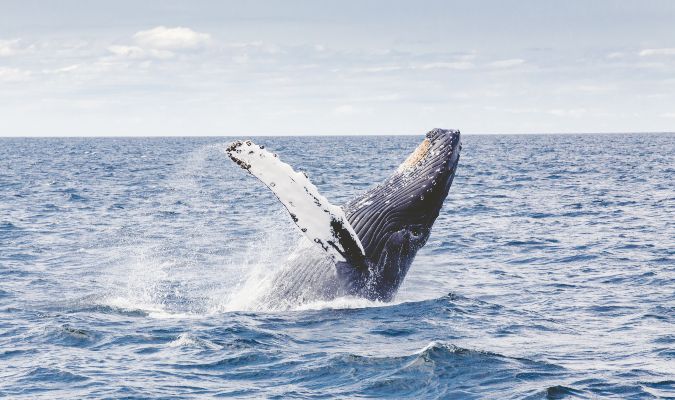Whale watching in Puerto Vallarta should be near the top of every bucket list. Every winter enormous humpback whales arrive in the Bay of Banderas to give birth and mate. During their stay, they love to leap from the waters and flop back to the surface with an almighty crash, sending water in all directions.
Being able to watch this extraordinary spectacle up-close is a humbling, often emotional, experience. But when is the whale watching season in Puerto Vallarta? And where do these leviathans come from? Here’s a guide with everything you need to know about whale watching in Puerto Vallarta.
Whale watching in Puerto Vallarta
When is the whale watching season in Puerto Vallarta?
Whale watching season in Puerto Vallarta runs from mid-December to March. However, you may be lucky enough to see breaching whales a few weeks before and after. The exact dates will change from year to year (it ran from December 8 to March 23 in 2018).
When is the whale watching season in Puerto Vallarta in 2019?
This year, the whale watching season runs from December 15, 2019 to March 15, 2020.
What kind of whales are in Puerto Vallarta?
The majority of the whales you will see in Puerto Vallarta’s Bay of Banderas are humpback whales. However, Bryde’s Whales have also been seen in the waters, albeit rarely. Puerto Vallarta’s seas are also home to plenty of other large marine animals but more on that later…
How close can you get?
How close you can get to the whales depends on the type of boat you are traveling in. Smaller vessels (those under 10 meters long) have to be at least 60m from the nearest whale. Boats larger than 10m must be at least 80m away.
Additionally, the law states that a maximum of four boats are allowed around a whale at any one time. If another captain would like their passengers to see the same whale, they must wait a minimum of 240m away until one of the original boats leaves.
Whales, however, are unaware of the rules laid down by the Mexican government and may approach boats of their own accord (they can get a little curious!). In that case, captains must have their engines in neutral and cannot move the boats until the whale moves away.
Where do the whales come from?
The humpbacks in Puerto Vallarta are not permanent residents but a migratory species that visit once a year. The whales that arrive in the Bay of Banderas come from the west coast of Canada and the United States, travelling past Baja California until they reach Puerto Vallarta’s shores. The voyage is a relatively short one (it can take just 40 days for some of the animals).
After their stay in Vallarta, the whales will return once more to the waters off Canada and the US to feed and build up their strength for their next Mexican vacation.
Read more: How to Optimize Your Whale Watching Experience
Why do they go to Puerto Vallarta?
Around 700 humpback whales arrive in Puerto Vallarta to give birth and mate. The natural shape of the bay provides protection for the mothers and their calves, which allows the youngsters to get through the tricky start to life in relative safety.
The majority of births take place from the end of December until the end of January. After that period, you are more likely to spot mothers and calves together when you go whale watching.
Interestingly, the whales will not feed at all during their time in Puerto Vallarta. Instead, they consume their food during the summer months in the US and Canada, building up their strength for the long, winter months.
Can I get in the water with them?
No, absolutely not. The whales in Mexico are protected by law. This stops any activity which might interrupt their day including diving, swimming, water skiing, parachuting, or fishing near to them.
The same rules also mean you can’t feed the whales, throw trash in the water, or disrupt the animals in another way.
JM TIP: If you would like to swim with a giant, you can snorkel with whale sharks in Los Cabos and off the coast of the Yucatan Peninsula. Read more here.
What other animals are there in Banderas Bay?
The Bay of Banderas is home to plenty of other animal life. At varying times throughout the year, the waters are home to bottlenose dolphins, spotted dolphins, rough toothed dolphins, and spinner dolphins.
You may also see orca (killer whales) and false killer whales, although you would need to be very lucky to spot them. Manta rays and sea turtles can also be seen swimming off the shores of Vallarta.
Are there sharks in Puerto Vallarta?
There have been no reported sightings of sharks within the Bay of Banderas. Manta rays are part of the shark family but only eat tiny prey such as plankton and small crustaceans.
Can you see the whales from the shore?
Yes! It is possible to see leaping humpback whales from the shores of Puerto Vallarta, even without binoculars. As the whales tend to stay away from the immediate shore, you may need to scan the distance for signs of activity.
Spotting a humpback whale from the shore is partly based on luck, but you can increase your chances by looking for these tell-tale signs:
- A cluster of boats: If you see a number of vessels gathered in one area you can be fairly certain that a whale is nearby.
- A plume of water: Whales breathe through blowholes, firing out air as they come up for more oxygen. This releases a plume of water that can glitter in the sun. If you see one of those, it’s likely that it comes from a whale.
- A large tail: If you spot a tail above the surface then it’s almost definitely a humpback whale. Humpbacks dive below the surface and stay under for up to 15 minutes on average (although they can stay under for up to 45 minutes).
JM TIP: If cooling off in an infinity pool while watching humpbacks leap from the water sounds like your perfect holiday, read our blog post, which features three villas from which you can do just that.
How can I arrange a whale watching tour?
If you’d like to see the leaping humpback whales of Puerto Vallarta, then book your vacation with Journey Mexico. Our Travel Planners have unrivaled connections and knowledge of the area, which means your whale watching tour will be conducted by the very best operators around.
We’re also dedicated to working with eco-friendly tour guides who, not only have inside knowledge on all the whale hotspots, but aim to care for the animals and the environment in which they live.






